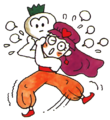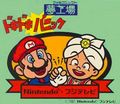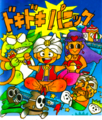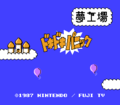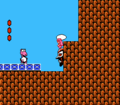Yume Kōjō: Doki Doki Panic: Difference between revisions
| Line 51: | Line 51: | ||
*Some [[vegetable]]s looked slightly different. | *Some [[vegetable]]s looked slightly different. | ||
*[[Cherry|Cherries]], POW Blocks, vines, grass tufts, [[Crystal Ball]]s, [[Bomb (item)|Bomb]] fuses, water, cloud platforms, and spikes are still, unlike in ''Super Mario Bros. 2'', where they are animated. | *[[Cherry|Cherries]], POW Blocks, vines, grass tufts, [[Crystal Ball]]s, [[Bomb (item)|Bomb]] fuses, water, cloud platforms, and spikes are still, unlike in ''Super Mario Bros. 2'', where they are animated. | ||
*[[Albatoss]] has only two frames of animation, while ''Super Mario Bros. 2'' gives it eight (with only seven showing up outside of remakes due to a glitch).<ref>[https://tcrf.net/Super_Mario_Bros._2_(NES)#Eighth_Animation_Frame The Cutting Room Floor]</ref> | |||
*Waterfalls move much faster. | *Waterfalls move much faster. | ||
Revision as of 17:55, July 20, 2018
The title of this article is official, but it comes from a non-English source. If an acceptable English source is found, then the article should be moved to its appropriate title.
Template:Infobox Yume Kōjō: Doki Doki Panic (translated as "Dream Factory: Heart-Pounding Excitement") is a Japan-only video game developed by Nintendo in cooperation with Fuji Television for the Family Computer Disk System to promote its event called Yume Kōjō '87 (translates to Dream Factory '87).
It was later released outside of Japan in an altered format under the name Super Mario Bros. 2, since the original Japanese Super Mario Bros. sequel, Super Mario Bros.: The Lost Levels, was deemed too similar to the original and too difficult for overseas players. Eventually, the altered Mario version of Doki Doki Panic was released in Japan as well, under the title Super Mario USA.
Story
The game takes place inside a book. The book's story tells of the land of Muu, where the quality of dreams determined the quality of the weather the next day. Because of this, the Muu citizens invented a dream machine so they could always have good dreams. One day, an evil toad named Mamu (whose name was changed to Wart for Super Mario Bros. 2) invaded the land and twisted the dream machine into a nightmare machine. However, the Muu people learned of his weakness to vegetables and used them to defeat him.
The book had found its way into an Arabian family. Their pet monkey, Rusa, gives the book to twins Poki and Piki. However, the twins quarrel and end up ripping out the last page of the book, causing its ending to be erased. Mamu, freed, reaches through the pages and grabs the twins, pulling them into the book. Rusa gets the twins' parents, Mama and Papa, their brother, Imajin, and Imajin's girlfriend, Lina[1], and they enter the book to rescue them.
Impact on the Mario franchise
The Doki Doki Panic engine started as a Mario-style tech demo using vertical-scrolling mechanics as opposed to side-scrolling mechanics[2]. Shigeru Miyamoto suggested the inclusion of side-scrolling mechanics to make it more of a Mario concept. Nintendo entered a licensing deal with Fuji Television, and the game's development proceeded with Yume Kōjō characters. Shigeru Miyamoto, as a result, was more involved with the development of Doki Doki Panic than he was in what eventually became the original Super Mario Bros. 2. Many of the game's enemies have become generic Mario enemies, though many were not intended to be that at the time of their creation. This includes Shy Guys, Birdos, Pokeys, Bob-ombs, and numerous others. Of particular note is how Mario, Luigi, Toad, and Princess Toadstool's skills and attacks have been shaped by the skills of the characters they replaced.
Some Mario elements had already been in place prior to the overhaul for America - both POW Blocks (from Mario Bros.) and Starmen (from Super Mario Bros.) are frequent and powerful items that serve the same purposes as in their games of origin.
Differences between games
Several changes were made in order to make the game appropriate for the Mario franchise. Graphical changes were made for certain enemies and characters. Additionally, the cream white Mouser boss was replaced with Clawgrip. This change was in tune with the decision to release the edited Doki Doki Panic in place of the Japanese Super Mario Bros. 2, which Nintendo of Japan feared was too hard for European and American gamers.[3]
Characters
- Imajin is the balanced character. While Mario replaces him, Imajin's balance in all areas has since become a staple of Mario's in certain games.
- Mama has the ability to jump higher and lightly hover at the top of her jumps. Luigi takes her place as he had already had higher jumps than Mario in Super Mario Bros.: The Lost Levels. However, Luigi can jump slightly higher than Mama. Like his brother's balanced stats, his higher jumps has stayed in the Mario franchise.
- Lina can hover, although she is low in speed and strength. Princess Toadstool replaces her. As a result of the license with Fuji Television expiring, Peach inherited Lina's floating capability and it would be later seen in the Super Smash Bros. series starting with Super Smash Bros. Melee (her first appearance in the series), Super Mario 3D World and Super Mario Run (with the addition of slowly descending in mid-air).
- Papa is the strongest character in the game and can run the fastest, but he is not very good at jumping. While Toad takes his place, in future video games (other than indirect references in Wario's Woods and Mario Superstar Baseball), Toad rarely has Papa's stats. However, Toad regains these properties in Super Mario 3D World, where he is the fastest character and a poor jumper.
- Poki and Piki are non-playable characters who get captured by Wart at the beginning of the game and are rescued after his defeat. They are replaced by the Subcons in Super Mario Bros. 2, which are also present in Doki Doki Panic's endings.
Visuals
- Shells were originally Blackface heads. They were edited in the western releases due to the controversy over blackface mocking African-Americans.
- Magic Potions were originally Magic Lamps. Magic Lamps were also present in the prototype version of Super Mario Bros. 2, as the Magic Potions weren't implemented yet.
- Mushrooms were originally Hearts.
- 1-Up Mushrooms were originally the heads of the character being controlled.
- Grass tufts were black instead of red.
- Mask Gates were originally generic masks instead of hawk masks.
- The explosion icon says "BOM" in Doki Doki Panic, and "BOMB" in Super Mario Bros. 2.
- Phantos were less menacing originally.
- Mushroom Blocks were originally various masks.
- Some vegetables looked slightly different.
- Cherries, POW Blocks, vines, grass tufts, Crystal Balls, Bomb fuses, water, cloud platforms, and spikes are still, unlike in Super Mario Bros. 2, where they are animated.
- Albatoss has only two frames of animation, while Super Mario Bros. 2 gives it eight (with only seven showing up outside of remakes due to a glitch).[4]
- Waterfalls move much faster.
Miscellaneous
- The title screen is entirely different.
- The title screen music is the credits theme from Super Mario Bros. 2, but without the sampling from the Super Mario Bros. overworld theme.
- Rather than the storyline taking place in a dream world, it takes place within a storybook. The plot of the game is about two kids named Poki and Piki who fought over reading a book and ended up getting themselves pulled in by Wart after accidentally tearing out the last page. A monkey known as Rūsa witnessed this and informed the Arabian family.
- In Yume Kōjo: Doki Doki Panic, the intro screen of the levels were actually pages from the right side from the story book, it did have the level text refereed to as "Chapters", it have page number marks that were commonly used in the story books, and it lacked the location icons. In Super Mario Bros. 2, the intro screen were heavily edited to make it look like a card since Yume Kōjo: Doki Doki Panic's story settings were from a story book instead of a dream, the text of "Chapters" were changed to "Worlds" since Worlds are commonly used in the Mario franchise, the page number marks were completely removed in the level's intro screen, and it added the location icons.[5]
- A save feature is included.
- The player cannot run by holding the
button, as that was a feature that was exclusive to the Mario franchise.
- It takes four hits for Wart to be defeated in Doki Doki Panic, two less than in Super Mario Bros. 2; This is also present in the prototype version of Super Mario Bros. 2.
- Sound effects are changed, as the Disk System adds audio hardware not present in the NES.
- After leaving a Key's homeroom, a Phanto inexplicably begins assaulting the player out of nowhere. In Super Mario Bros. 2, the Phanto now appears, albeit stationary and (seemingly) harmless, in the Key's homeroom. However, once they Key is retrieved, the Phanto comes to life and begins attacking.
- An albino version of Mouser appeared as the boss of 5-3. In Super Mario Bros. 2, he was replaced with Clawgrip. His replacement was likely because albino Mouser attacked much more erratically than his grey-skinned counterparts, thus making him seem too powerful. Because of this, Clawgrip is the only boss exclusive to Super Mario Bros. 2.
- The highest cloud platform in a section of 7-1 was removed, and the gray Snifit was moved onto a pillar where the cloud was once attached to.
- Imajin, Lina, Papa, and Mama do not shrink when they have one hit point left.
- The characters and artwork are based on an Arabian style theme.
- The Subspace music for Super Mario Bros. 2 is the overworld theme for Super Mario Bros., while the music for Doki Doki Panic is an Arabian theme.
- The musical score for the player select and overworld themes are slightly shorter. The extended rhythms are exclusive to Super Mario Bros. 2.
- Enemies scream when defeated.
- Upon grabbing the Starman, an Arabian-sounding tune plays in Doki Doki Panic, while the standard Super Mario Bros. Starman fanfare plays in Super Mario Bros. 2.
- The player must beat the game with all four characters to view the ending in Doki Doki Panic, unlike Super Mario Bros. 2, where the player only needs to beat the game once to view the ending. However, due to Doki Doki Panic being on the Famicom Disk System, each characters' progress through the game was independently saved and could be returned to at a later date.
- The shortcut in 6-3 is slightly different: in Doki Doki Panic, one can simply jump down from the cloud platform with the door, however in Super Mario Bros. 2 two more cloud platforms stand between the door and ground.
Gallery
Artwork
- DDP-Twins&Rusa.png
The twins and Rūsa
- DDP-Twins&Wart.png
Wart kidnapping the twins.
- Wart dokidokipanic.png
Wart kidnapping the twins.
- Dokimachine.png
- DDP-SlotMachine.png
Imajin playing the slot machine minigame.
Artwork of Mario and Imajin shaking hands.
- Promotional Poster - Doki Doki Panic.png
Promotional poster
Artwork of (going counterclockwise) Princess Peach, Mario, Imajin, and Lina with a magic lamp. This artwork can be seen on a telephone card.
- Grayguy.png
An unused Shy Guy in the manual
- Sanbo.png
Sprites
- Imajin Sprite - Doki Doki Panic.png
Imajin
- Mama Sprite - Doki Doki Panic.png
Mama
- Papa Sprite - Doki Doki Panic.png
Papa
- BeeShyGrayGrey.gif
- BeeShyGreen.gif
Green Beezo
- BeeShyRed.gif
Red Beezo
- ShyguyRedLeft.gif
Screenshots
- Doki vs smb2.png
Comparing Yume Kōjō: Doki Doki Panic with Super Mario Bros. 2.
- Dokidoki-panic.png
Imajin in World 1-1
- WhiteMouser.PNG
Papa facing Mouser
- Ddp wart.png
Papa Facing Wart
- Wartmama.png
Mama facing Wart
Lina facing Birdo
Box art
Media
- For a complete list of media for this subject, see List of Yume Kōjō: Doki Doki Panic media.
Yume Kōjō '87
Doki Doki Panic was based on Yume Kōjō '87, an event sponsored by Fuji TV held from July 18th to August 30th, 1987. On the last day of this event, there was a grand finale to celebrate all the good times they have brought on to the people of Japan. [6] It was meant to represent a new generation of media that would arrive in the years to come, with various technical displays, as well as advertise Fuji TV's fall lineup of shows. Elements from the event carried over to the game include the characters of Papa, Mama, Imajin, Lina, Poki and Piki, the blimp on the title screen and the use of masks as a visual motif.
Staff
- Main article: List of Yume Kōjō: Doki Doki Panic staff
References in later medias
- Super Mario Bros. 2: Yume Kōjō: Doki Doki Panic is the source of Super Mario Bros. 2, and few differences exist between the games. In addition, Doki Doki Panic's cover art was traced and edited into a piece of official art for Super Mario Bros. 2. The credits theme from Super Mario Bros. 2, which replaced a completely different song from Doki Doki Panic, is remixed from an arpeggiated chord progression and melody taken from Doki Doki Panic's title screen / intro theme, a song which likewise does not exist in Super Mario Bros. 2.
- Super Mario (Kodansha manga): During the Super Mario USA adaptation, Princess Peach, trapped in Subspace, finds a Magic Lamp from Doki Doki Panic. Birdo states it is useless and instead pulls out its Super Mario Bros. 2 equivalent, the Magic Potion.
- Wario Land II: A Big Face (revised as a Turtle Shell in Super Mario Bros. 2) can be found as a treasure in Chapter 3, Story 4: Escape from Maze Woods.
- Mario Kart 8 / Mario Kart 8 Deluxe: On Toad Harbor, there is a sign saying "Shy Guy Metals: Since 1987", while this game was the debut of Shy Guys, and it was released in 1987.
- Super Mario 3D World: The player being required to beat all levels with all characters (Mario, Luigi, Toad, Princess Peach, and Rosalina), barring the Captain Toad levels, to unlock all related stamps as well as all five profile stars was most likely a reference to how the player was required to beat all levels with all characters (Imajin, Mama, Papa, and Lina).
- Super Smash Bros. for Wii U: The trophies for Birdo and Shy Guy mention that they actually debuted in Doki Doki Panic (removing the Yume Kojō part of the title, presumably due to licensing concerns).
- Paper Mario: Color Splash: At the concert in Plum Park, Birdo sings about "doki doki panic" and eggs spit on people's faces, referencing her first appearance in this game.
Names in other languages
| Language | Name | Meaning | Notes |
|---|---|---|---|
| Japanese | 夢工場 ドキドキパニック[?] Template:Nowrap |
Yume Kōjō means "Dream Factory", while doki doki is Japanese onomatopoeia for a rapidly beating heart and panikku is a transcription of the English "panic", so in effect, it can be translated as "Dream Factory: Heart-Pounding Panic". |
Trivia
- The coin counter in Bonus Chance segments is displayed in hexadecimal. When the player gets more than nine coins in a level, letters from A to F are used instead.
- Despite appearing in the manual, no Gray Shy Guys appear in the game.
- Coincidentally, some promotional material feature Imajin and Lina posing with Mario and Princess Peach, their eventual replacements in the Western Super Mario Bros. 2 (called Super Mario USA in Japan).
External links
- From Doki Doki Panic to Super Mario Bros 2 at The Mushroom Kingdom
- Wikipedia
References
- ^ https://www.youtube.com/watch?v=KL9o9zzCUsQ&t=8m38s
- ^ http://www.wired.com/2011/04/super-mario-bros-2/
- ^ http://www.youtube.com/watch?v=DNa0M1gymgA&feature=related
- ^ The Cutting Room Floor
- ^ https://youtu.be/fXyHr3ZuVc8?t=46
- ^ Gaijillionaire (July 17, 2016), Yume Kojo! Not The Story of Super Mario Bros 2 vs Doki Doki Panic Nintendo NES History Fuji TV | Gテレ

